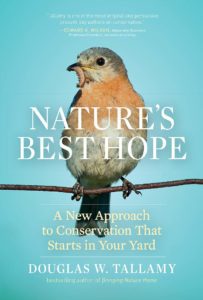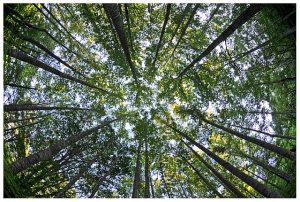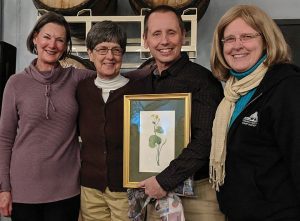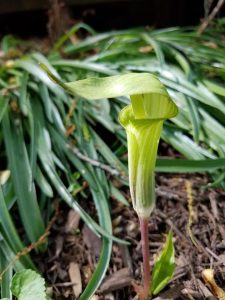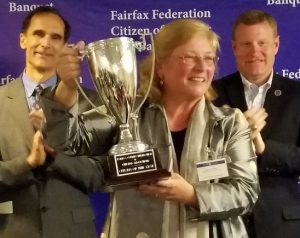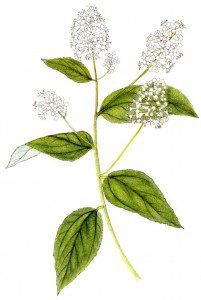Book Review: Nature’s Best Hope by Doug Tallamy
By Sue Dingwell In his new book, Nature’s Best Hope, Dr. Doug Tallamy has delivered a deep and powerful wellspring of inspiration for the many people craving an opportunity to be part of transformative change for our challenged world. Even more compelling than his first book: Bringing Nature Home, a seminal work in itself, Nature’s…
Wildflower of the Year 2020 Wild Geranium (Geranium maculatum)
Wild Geranium is a woodland perennial herb. Plants emerge from stout, shallow, rhizomes bearing knobby leaf scars and thin roots. Aerial stems attain heights of 2 to 7 dm; stem hairiness ranges from a few scattered trichomes to densely pubescent. Leaves are crowded basally, but well separated and opposite on flowering stems. Overall leaf shape…
Downy Lobelia: An Overlooked Garden Native
By Betsy Washington Several of our native Lobelias are well loved and absolutely beautiful. Cardinal Flower with its brilliant red flower spikes, and Great Blue Lobelia with its crowded spires of deep blue flowers, are familiar to many gardeners. Downy Lobelia (Lobelia puberula), which is less well-known, graces roadside ditches, low and upland woods, riverbanks…
VNPS Funded Research Reveals Which Trees are Dying and Why
Editor’s Note: This post describes the 2019 research project conducted by Alyssa Terrell and supported by a VNPS Research Grant and was edited for publication. Our Research Grant Program awards funds for well-defined projects whose results can be evaluated and which address the VNPS Mission and Goals. Learn more about the Grant Program and how…
Pawpaws And The Zebra Swallowtail Butterfly
By Mary Lee Epps Pawpaws have a great deal to offer—handsome flowers in the spring, delicious and highly nutritious fruit in the early fall, plus they are the only host plant of one of our most beautiful butterflies, the zebra swallowtail. Our pawpaw (Asimina triloba) is the northernmost member of the mostly tropical Annonaceae (or…
Save Plants, Save The Planet, Save Ourselves — Native Plants and Nature Based Solutions to Climate Change And Other Threats to Humanity
By Emily B. Roberson and Doug Tallamy for the Native Plant Conservation Campaign Sea level rise, record breaking heat waves, floods, pollution, mass extinction — 2019 is frightening! What if there were one simple thing individuals, businesses and communities could do to address these problems? There is! Plant native plants! Native wildflowers and trees are…
‘Spirit of Inquiry’ drove Chris Ludwig
Chris Ludwig, botanist, zoologist, and general all-arounder with the Virginia Natural Heritage Program, is off to greener pastures after 30 very busy years in the conservation community. And I do mean actual pastures right now since, as I write, Chris and his wife, Jolie, are staring out across the Serengeti as wildebeest swarm and flocks…
Jack-in-the-Pulpit Preaches Preservation
Unlike many wildflowers that make a beautiful but brief spring appearance, the perennial Jack-in-the-pulpit (Arisaema triphyllum) appears later in April and continues to add interest to moist woodlands until late fall. The hooded inflorescence which resembles a pulpit (a spathe) has a “Jack” (a spadix) standing in the center as if delivering a sermon. Perhaps…
VNPS Member Catherine Ledec Named Fairfax County Citizen of the Year
Recently I had the pleasure of attending a banquet where VNPS member Cathy Ledec was honored as Fairfax County’s 2018 Citizen of the Year. How gratifying it is to see someone recognized for efforts in preserving our natural environment! This prestigious award has been presented for the past 69 years by the Fairfax County Federation…
Wildflower of the Year 2019 New Jersey Tea (Ceanothus americanus)
New Jersey Tea is a low shrub, generally less than 1 m tall and often profusely branched. Stems are finely hairy, but may become smooth with age. Vegetative stems are perennial, but flowering stems persist for just a single year. Leaves are mostly 5 to 10 cm long; leaf shape varies from narrowly to widely…

